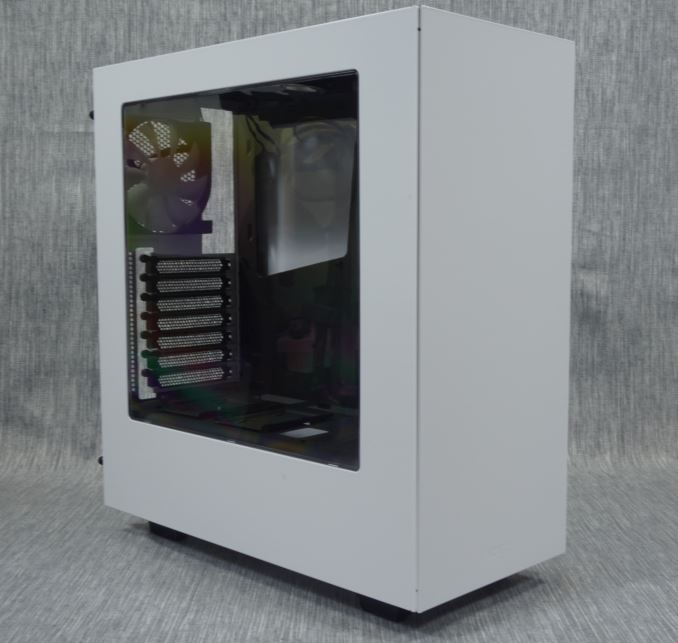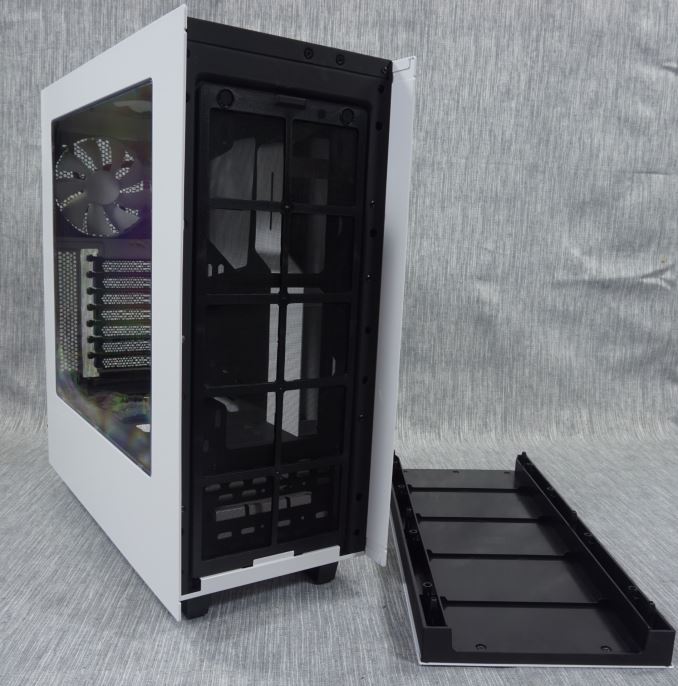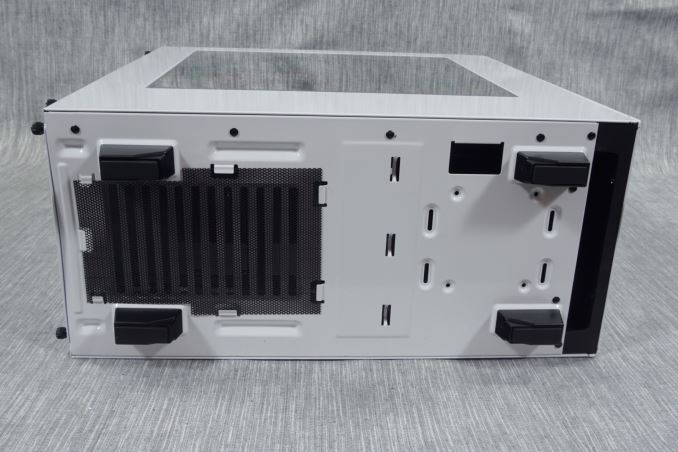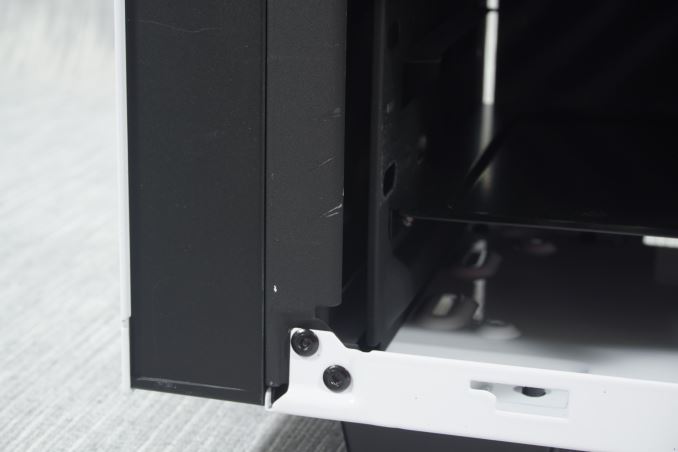The NZXT S340 Case Review
by E. Fylladitakis on July 13, 2015 8:00 AM EST- Posted in
- Cases/Cooling/PSUs
- NZXT
- Case
- ODD-Free
The Exterior of the NZXT S340
In terms of design, the S340 is just about as minimalistic as it gets. It literally is just a rectangular metallic box, with an entirely flat faceplate and side panels. Even the company logo that is embossed near the bottom of the faceplate is difficult to discern. We received the white version of the S340, which has a glossy exterior with matte black accents and a black interior. The left side panel of our sample is partially windowed, revealing the entire system compartment but leaving out the area where the PSU and the 3.5” drives are.
As we anticipated, the metallic faceplate is just a sheet of metal attached on a thick plastic frame. This is natural for both practical reasons and considering the price of the case. The flexibility of plastic allows for panels that can be easily attached to and removed from the metallic frame of the case, whereas a metallic construct would be heavy and it would definitely require some sort of locking mechanism or screws to stay in place. A very large nylon air filter covers the entire front of the case behind the front panel. As we mentioned in the introduction, there is not a single 5.25” device bay.
One of NZXT's primary marketing points regarding the S340 is its compact size. True enough, the S340 is very small for a tower case, with a volume of just 0.0384 cubic meters. This makes it even smaller than the Corsair Obsidian 350D (0.0416m3, 8% greater volume), a case that is limited up to micro ATX motherboards. It also is much smaller than the SilverStone Fortress FT05 (0.0456m3, 17.15% greater volume), which also is an "ODD-Free" design. The extensive use of steel makes the S340 a relatively slightly heavy case for its size, tipping the scales at 7 kg while completely empty.
Even though the interior of the case is black, the rear and bottom of the frame are sprayed with the same glossy white color as the faceplate and side panels. The PSU compartment is at the bottom of the case, where four thumbscrews are holding a cover in place. As we will see later, the PSU can only be installed by taking off this cover and inserting a PSU from the back of the case. A very basic metallic mesh filter can be found at the bottom of the case, covering the opening of the PSU intake. It also is noteworthy that the S340 has slightly tall feet for a case of this design and size.
The top of the S340 is matte black with all versions of the case, including the white version that we received for this review. The power on button, two USB 3.0 ports and the two headphone jacks can be found at the right front edge of the top panel. A LED ring surrounds the power on button, serving as the power on indicator.
The matte black color of the top and the interior of the case is very smooth and has an excellent feel to the touch. However, it also is very easy to scratch. This will be particularly obvious on the front frame, where the latches of the side panels lock. The matte paint at the sides of the front frame was already scratched when we removed them for the first time. One should be very, very careful when working with the S340, especially around its interior.

















48 Comments
View All Comments
Qrash - Monday, July 13, 2015 - link
I feel it would be preferrable to use liters instead of cubic meters when listing the volume of a case. For the NZXT S3430 the volume is 38.4 liters which I prefer to 0.0384 cubic meters. For small mini-ITX cases, the volume is often listed in liters.Wardrop - Monday, July 13, 2015 - link
I agree. Litres seems to be more standard in the industry.ES_Revenge - Monday, July 13, 2015 - link
Fitting the monster GPUs of today is one reason... At least AMD is trying to end that trend with the super-short Fury cards. But yeah other than that GPU length has gotten out of hand IMO.powerwiz - Tuesday, July 14, 2015 - link
You would be correct on that. My MSI 980 GTX is about as long as they get in terms of length. I would of been screwed getting it into a smaller case other then the one I recently chose.I think the main reason for them being longer all of a sudden is to spread out the electronics for heat dissipation.
Shadow7037932 - Monday, July 13, 2015 - link
Good to see more cases ditching the 5.25" drive bays. I haven't put one of these drives in a system since 2005. USB DVD RW works well enough in the rare case I need to use it. Even for OS installs, I just use flash drive since it's faster.With that being said, I do wish they made an add-on item for extra 2.5"/3.5" bays to go where the 5.25" drives would have been. Something similar to the removable drive bays we've seen in other cases.
Sushisamurai - Monday, July 13, 2015 - link
So, i'm assuming HSF (first page, by GPU clearance) is in reference to a CPU cooler? It certainly looks like a nice, minimalistic case - cable routing to the bottom right corner of a motherboard would look fairly difficult as I don't think the cables were meant to be run in front of the cable holding panel thing. I wonder though, how much clearance is there from the top fan to the motherboard, as some motherboard heat sinks are really thick and the provided example build picture doesn't really illustrate if that may be a problem.Good catch on the negative pressure airflow problem for cooling the HDD's. Good review/read; if I could make a suggestion, I think you should have also added the Bitfenix prodigy as a temperature/price comparison. Crank out more case reviews!
Samus - Monday, July 13, 2015 - link
It actually is a really nice looking case. I'm glad to see more minimalistic, less gaudy designs. Some of these cases over the years have been ridiculous. Even the likes of Silverstone aren't immune to aesthetic screw-ups (the Raven's, in my opinion, are ridiculous looking, especially when they are internally similar to the fantastic looking Fortress's)jabber - Monday, July 13, 2015 - link
Would look even better with no windows.mr_tawan - Monday, July 13, 2015 - link
At first I thought this is ... "odd-free" design, and wondered what is that 'odd' means ? everything comes in even number ? Then I realized later that it actually is "ODD-free" (as Optical Disc Drive). Take me a few hours to realize lol.BrokenCrayons - Monday, July 13, 2015 - link
I like the overall style of the case, but I personally find it a little bit large though I understand there are some space compromises that have to be made to handle ATX specifications. What I think is a bigger problem is the lack of USB ports. With there being no optical drive, I think an increase in front or top accessible USB ports becomes more important for things like memory card readers, flash drives, or occasional USB ROM drives since file exchanges don't always happen over a network connection.